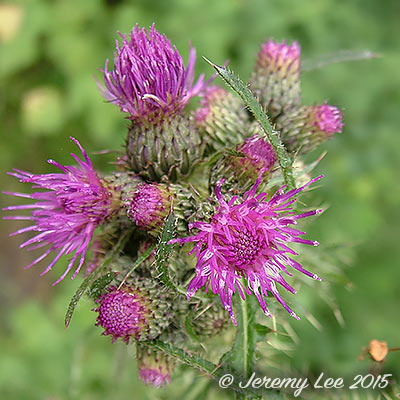
 |
|
Scientific Classifications explained » Amphibians » Ants » Aphids » Bees » Beetles » Birds » Bugs » Butterflies » Caterpillars » Damselflies » Dragonflies » Earwigs » Flies » Frog/Leafhoppers » Fungi » Galls » Grasshoppers » Harvestmen » Hoverflies » Lacewings » Ladybirds » Leaf Mines » Lichens » Mammals » Millipedes » Mosses » Moths » Sawflies » Slugs » Snails » Spiders » Trees & Shrubs » Wasps » Wild Flowers » Woodlice » Postboxes |
UK Nature > Wild Flowers > Red & Pink Wild Flowers > Cirsium palustre

Common Name: Marsh Thistle Scientific Name: Cirsium palustre Cirsium palustre, or Marsh Thistle, is an herbaceous biennial (or often perennial) species of thistle. Found throughout Europe to central Asia, where it is particularly common on damp ground such as marshes, wet fields, moorland and beside streams. Common throughout the UK, it is a constant plant of several fen-meadow plant associations. This is a tall thistle which reaches up to 2 m tall. It germinates in autumn and over-winters as a basal-rosette of spiny, narrow leaves that have spiny, dark purple edges. Upright stems develop the following year. The tips of the stems branch repeatedly and bear candelabra of dark purple flowers, 10 to 20 mm across with purple-tipped bracts. The later leaves that develop are lobed. The flowers are produced from June to September and are occasionally white, in which case the purple edges to the leaves are absent. They are pollinated by bees, butterflies and flies. The seeds that mature are dispersed by the wind on fluffy carriers. |
|

https://www.uknature.co.uk is a website dedicated to showing the immense diversity of UK nature and wildlife. Our vast range of habitats, from lowland arable to snow covered mountains, from storm-ravaged coastlines to peaceful inland freshwater lakes and rivers, from dry, sandy heaths to deciduous and coniferous forests, all these habitats contribute to the abundance of UK nature. We have wild birds in huge numbers either residing or visiting our shores (597 recorded species as at July 2013) and we must also not forget the humble back garden with its grass lawns, flower beds filled with nectar rich flowers, shrubs and trees, all designed to attract huge numbers of insects such as bees, moths, butterflies and hoverflies; and finally the small ponds which provide safe havens for frogs, toads, newts and even slow worms and grass snakes. www.uknature.co.uk is the showcase for my personal passion, photographing uknature in all its glory. I sincerely hope you all enjoy the fruits of my labours. This site and all images contained therein is © Jeremy Lee 2004 - 2025. All Rights Reserved. Site design by Jeremy Lee. Site development & IT Support by Stuart Lee. |